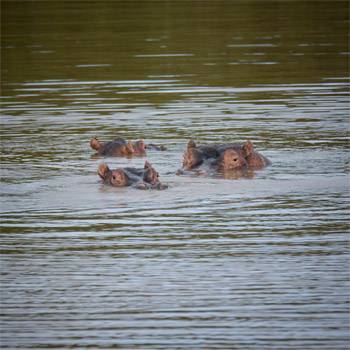World Hippo Day

World Hippo Day
The Masai Mara National Reserve
Home to the rare pink hippo, and known for its annual wildebeest migration, the Masai Mara is known across the world as one of the best destinations for safari experiences in Africa. The Masai Mara game reserve is home to the big 5 and other wildlife. It is located in the rift valley region and extends to about 1,501 square kilometers. The Masai Mara is well known across the world because it is home to the 7th World Wonder, the great wildebeest migration. Every year, guests visit the Masai Mara to be part of this phenomenon. Around 2 million wild animals are involved in this migration that starts from the Serengeti in Tanzania, through the Mara River into Kenya's Masai Mara.
Kora National Reserve
The Kora National Park was made a wildlife reserve back in 1973, and as a wildlife park in 1990. It covers an area of just over 1,700sq km. This triangle of dense woodland and scrub spreads along the Tana River, which rises in the highlands between Aberdares and Mount Kenya before descending towards the Indian Ocean. The pristine wilderness of the Tana River is complemented by the stunning Adamson's Falls and Grand Falls, creating diverse scenery for visitors. The park is home to a large hippo population as well as big cats and several antelope species. The Kora National Reserve is an all year round destination, so no matter when you visit you're guaranteed to see these amazing animals.
Mwea National Reserve
Located 160km north-east of Nairobi, the Mwea National Reserve is in the Mbeere District, Eastern Provence. Visitors to the reserve can enjoy boat rides at the Kamdaru Dam and Hippo Point, as well as a walking trail. As the name suggests, Hippo Point is one of the best places to see hippos in their native habitat. The reserve is home to over 200 species of rare birds, elephants, giraffes, zebras, and buffalos, to name but a few.
The Tsavo East and Tsavo West National Parks
The Tsavo National park is divided into two parks separated by the Mombasa Nairobi highway. Both parks are located in the coastal region and this is the largest park in the country covering about 22,000 square kilometers. Of the 2 parks, Tsavo East National park is slightly larger than Tsavo West. Tsavo East is characterised by a flat terrain while the West is more mountainous and green. Tsavo West also has a number of swamps, rivers and springs. The Mzima Spring is located in Tsavo West and guests get the chance to watch hippos from under water at this location.
Bisandi National Reserve
Bisandi National Reserve acts as a wildlife dispersal area for Meru National Park. It is home to three permeant rivers that give the diverse wildlife a better habitat all year round, attracting a large population of hippos to this part of Kenya. Due to its untouched nature, visitors have the option to either camp or stay at the Offbeat Camp - this reserve is all about the natural surroundings. Whilst the hippos are the main attraction, this reserve is also home to over 400 species of birds.
A few things you didn't know about hippos:
- The name hippopotamus means -river horse' and is often shortened to hippo.
- The hippopotamus is generally considered the third largest land mammal (after the White rhinoceros and elephant).
- The closest relations of the hippopotamus are surprisingly cetaceans such as whales and dolphins.
- Although they look cute, they are regarded as one of the most dangerous animals in Africa.
- At birth, the baby, called a calf, is a whopping 50 to 110 lbs. (23 to 50 kg).
For more information please visit: www.makeitkenya.com
MORE





